7 SEO Certifications Real Learners Recommend
The best SEO certifications come from Semrush, Udemy, Hubspot, Blue Array, CXL, DMI, and Coursera.
The best SEO certifications come from Semrush, Udemy, Hubspot, Blue Array, CXL, DMI, and Coursera.
Do you remember the viral “Little Miss?” meme revival from 2022?
That’s a great example of trendjacking, or inserting your brand into viral online conversations.
It felt like every brand — from global airlines to your local coffee shop — jumped into labeling themselves. Some were hilariously on-point and others…well, not so. For every well-executed moment like a wellness brand that tailored their take to be timely, irreverent, and match their core voice, dozens more missed the mark. And like it or not, audiences can tell.
That’s the fine line with trendjacking. What was once a cheeky social media trick has become a high-stakes play for many modern social media marketers. To stand out and not alienate, brands need more than speed. They need emotional intelligence, audience awareness, and restraint to not jump on every viral moment.
How can you harness what’s trending without sounding tone-deaf or jumping the shark? Let’s break down the basics of effective trendjacking and how you can approach it in a smart way.
Trendjacking is the practice of injecting your brand into a popular or viral conversation to boost visibility, engagement, or relevance. Brands jump on trending topics like memes, social media challenges, or major pop culture moments to join the conversation in ways that are timely and clever.
Trendjacking really gained traction during the heyday of Twitter (now X), when brands like Oreo seized viral moments (the “You can still dunk in the dark” tweet during the 2013 Super Bowl blackout) and earned massive engagement for real-time creativity. That post was a signal to marketers that being culturally responsive could pay huge engagement dividends.
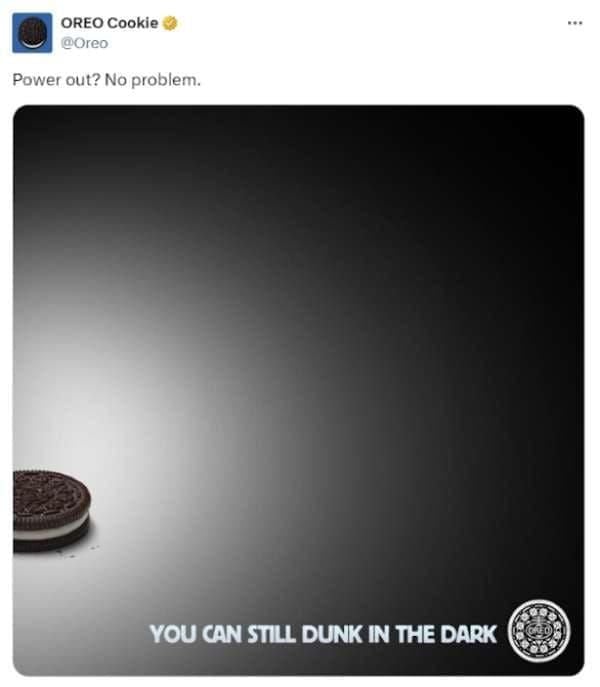

Trendjacking isn’t a completely new strategy, though. It has its roots in the older PR strategy of newsjacking. Popularized by David Meerman Scott, newsjacking focused on inserting brands’ perspectives into breaking news stories to get media coverage. Trendjacking is just an evolution of that strategy, tapping into a broader range of online moments.
When you do it well, trendjacking can help your brand show personality, relevance, and humor. But it’s not a strategy without risks, especially if you do it without considering nuance or alignment to your brand’s values.
Let’s say you’re ready to drive into trendjacking. How do you do it right? Like many effective social media strategies, the best trendjacking campaigns start long before a trend even surfaces. Success often hinges on preparation and cultural awareness, but the real secret is the agility to act fast without sacrificing your brand’s integrity.
Trendjacking starts with awareness. The earlier you spot a trend, the better your odds of leading the conversation rather than chasing it.
Start with traditional sources. Social listening tools such as AnswerThePublic, TikTok Creator Search Insights, or Sprout Social can surface what’s gaining traction across different platforms. The latter can help you keep an eye on places like X, Bluesky, TikTok’s trending page, Reddit threads, and even Google Trends to stay ahead of the curve. Using these tools doesn’t just tell you what’s trending. They help you catch the wave before it crests.
Effective trendjacking goes deeper than identifying meme formats or hashtags, though. Ask yourself these questions:
Take, for example, the “Girl Dinner” trend. It wasn’t just a meme. It was a commentary on autonomy, wellness fatigue, and the pushback against curated perfection.
In addition to staying on top of developing trends, think ahead. Certain events almost always spawn viral moments: award shows, the Met Gala, political debates, and major sporting events are excellent fodder for trends. Develop a calendar of these events and build a properly resourced team that can act when the internet lights up.
Before you jump into the trend, assess whether or not it’s right for you. Ask important, hard questions, like “Does this trend actually align with our brand?” and “Will our audience care?” Finally, will it feel authentic or forced?
Many brands falter here. Chasing a trend that’s off-brand does more than fall flat; it risks damaging your credibility. The Duolingo x Scrub Daddy “cursed collab” worked because both brands share a quirky, unfiltered tone. If a serious financial brand tried the same joke? Cue the confused and cringing followers.
Assess risk, too. Some trends carry baggage, like political undercurrents, social controversies, or rapidly shifting sentiment. Your internal team should include diverse perspectives to help flag possible missteps.
Beyond relevance, hopping on the trend should add to your brand’s story. If it doesn’t connect to your values or content pillars, it might be better to skip it. Not every viral moment is worth jumping into. Restraint is often what separates trend-chasers from trend leaders.
Once you’ve vetted a trend, it’s “go time.” Timing is everything in trendjacking. Wait too long, and you’re just adding noise to an already crowded feed.
In practice, your team needs a streamlined workflow to move from idea to pressing the publish button in hours, not days. Empower social managers with decision-making autonomy. Maintain a library of pre-approved assets like brand visuals, fonts, and tone examples so your team can capitalize on trends without needing to create a full-scale design from scratch.
Creating internal “trend kits” or rapid response playbooks can help your team execute quickly and safely. Remember: the most memorable trendjacks feel both spontaneous and strategically on-brand because they are.
Once you’ve identified the right trend and confirmed it makes sense for your brand to participate, the real magic begins: creating content to hit the sweet spot of relevance, creativity, and authenticity. Not every trendjacking post needs to be laugh-out-loud funny or ultra-slick, but it should always bring something fresh and on-brand to the table. Some tried-and-true strategies for creating trendjacking content that resonates include:
What works on TikTok might not work on LinkedIn, and vice versa. Tailor your content’s tone, format, and visuals to the platform you’re posting on. Wendy’s built their brand on X with snarky one-liners, but the food chain takes a more curated and visual approach on Instagram.
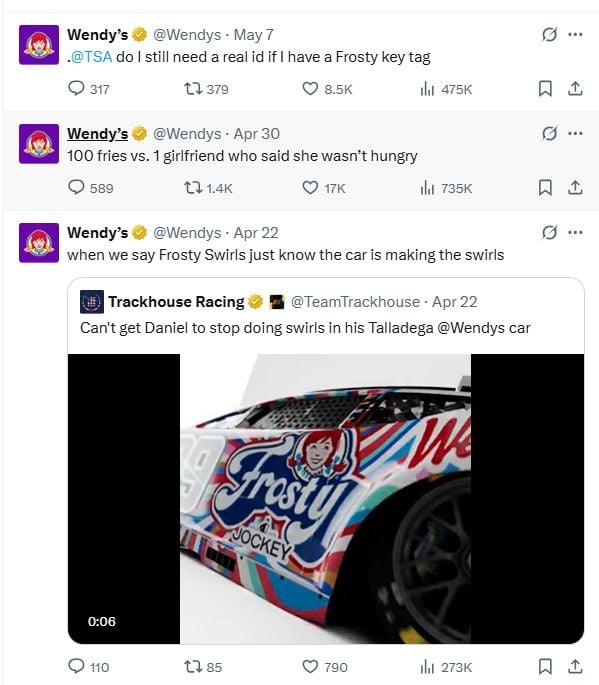

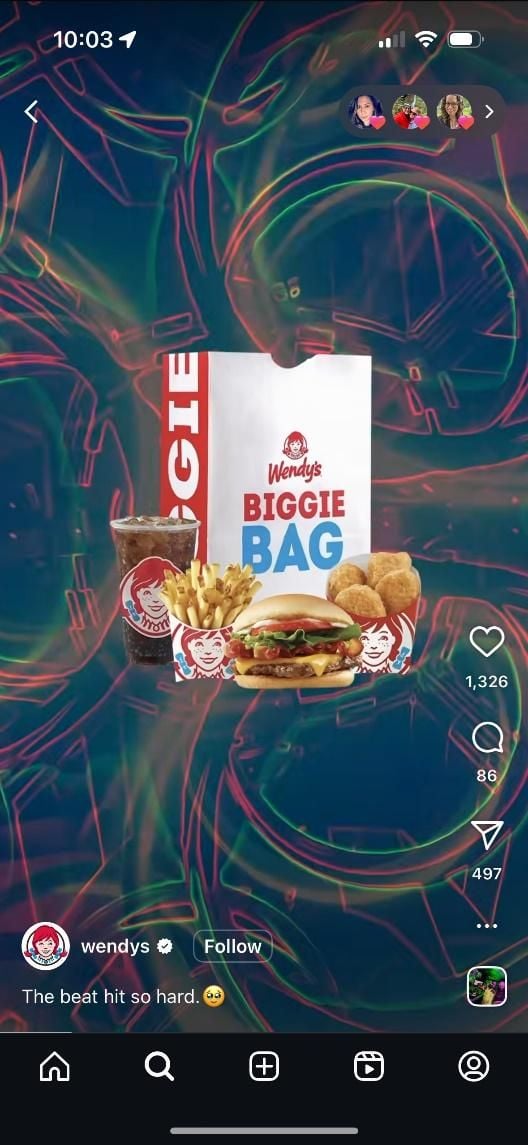

Humor, absurdity, and left-field creativity often fuel viral trends. But you can’t force it. Duolingo’s TikTok presence leans fully into weirdness, but it’s consistent with their edgy, millennial-savvy voice.
Don’t simply copy-paste a trending meme format. Add your brand’s POV, a clever twist, or insights that enhance the original. For example, Canva recently leveraged the app’s ability to create color schemes with the growing popularity of Labubu toys.
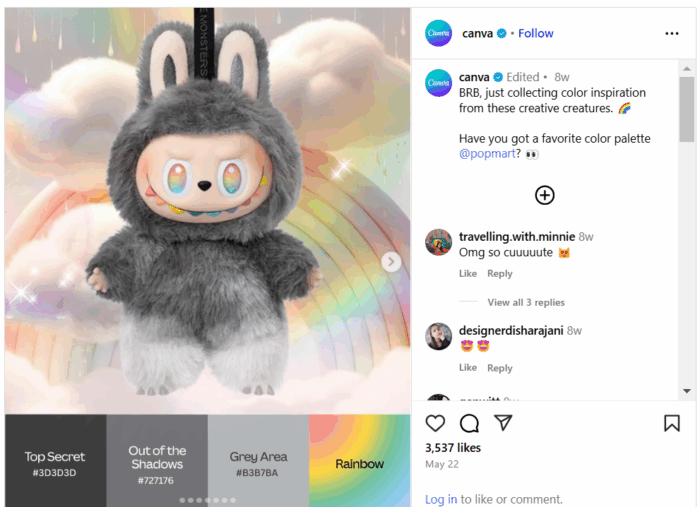

Your audience can smell a cash grab a mile away. If the trend doesn’t align with your values or voice, skip it. If you really feel like you need to participate, subtly nod to the trend without trying to dominate it. Engage, like, or reply to accounts that have posted content in the trend without creating new assets on your own.
Even in a fast-moving trend cycle, visuals (and sound) matter. Low-res graphics or clunky text overlays can kill your momentum. Use templates or pre-approved brand assets to keep things polished under pressure.


Trendjacking is not the time to let the copywriter have the keys to the Canva account.
Trendjacking is a real double-edged sword. When done right, it’s clever, memorable, and engaging. When done wrong, it’s also memorable, but for the wrong reasons; it’s tone-deaf, confusing, or even damaging to your brand. Avoid these common pitfalls.
Some trends are tied to serious or sensitive events, and misjudging the tone can result in intense backlash. That’s what happened to Pepsi in 2017 for their ad that featured Kendall Jenner, which co-opted protest imagery to sell soda (and promptly got called out for trivializing real social movements).
Just because a topic is trending doesn’t mean it’s safe territory. Assign someone on your team to assess social sentiment and cultural context before engaging.
Timing is critical. A trend that peaked two days ago may already feel stale, especially if your post doesn’t add anything new. Joining late makes your brand look like it’s scrambling to stay relevant, not leading the conversation.
To avoid this, consider streamlining your approvals process and having brand-safe assets ready to go.
One of the fastest ways to make a brand look out of touch is to misinterpret the trend altogether. Imagine someone at your company wanted to tweet a meme that referenced “Netflix and chill,” without realizing its NSFW subtext. The internet might notice and not in a good way.
Before trendjacking, do a quick sentiment check. What does this trend actually mean to the people participating in it?
If the trend doesn’t suit your brand voice, values, or audience, don’t force it. It’s painfully obvious when a B2B SaaS brand shoehorns itself into a Gen Z meme format meant for fashion or pop culture. This usually results in low engagement at best and audience cringe at worst.
Brands need a straightforward internal process for evaluating the risk of trendjacking campaigns. Who gets to greenlight? What criteria does the content meet? Building a lightweight risk assessment checklist or review board (creative + legal + DEI leads) can help you act quickly and responsibly.
Even with the best of intentions, things can go sideways fast. That’s why it’s smart to develop a basic crisis response protocol before engaging with fast-moving or culturally sensitive trends. Know who will respond, how quickly, and what steps to take if content sparks backlash.
With your trendjacking content out in the world, it’s time to answer the big question: Did it work?
Start by measuring the basics: likes, shares, reach, and impressions. These top-level metrics help assess immediate visibility and initial audience reaction.
Smart marketers go further, though. The most impactful trendjacking efforts don’t just rack up views. They strengthen brand equity and move the needle on meaningful outcomes. Ask yourself:
Want to level up your campaign? Try aligning your trendjacking posts with keyword-focused content or campaign themes. This gives your SEO strategy a boost, especially in a world where Search Everywhere is the norm (and users can Google the trend and stumble onto your brand).
The art and science of trendjacking will only evolve as the digital landscape shifts. Marketers who want to stay ahead of the curve will need to keep a pulse on what’s trending and how those trends take shape and spread. The future of trendjacking will evolve thanks to things like AI, new platforms, and the rise of “unpolished” realness.
AI is creating massive shifts in real-time marketing as tools like ChatGPT, Midjourney, and Runway help brands generate reactive content faster than ever. From clever captions to custom visuals, the future of trendjacking likely includes AI-enhanced creativity. The big challenge for brands is to remain authentic in the face of automation.
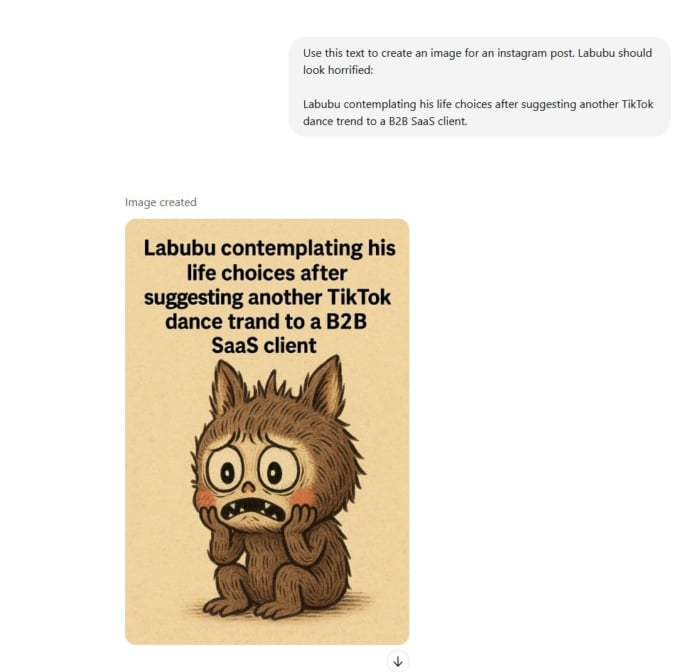

Could ChatGPT help brands jump on the enthusiasm for Labubu without spending the time to go out and source a doll? Possibly.
Instagram, TikTok, and X may reign supreme among platforms, but that won’t always be the case. Bluesky is becoming increasingly popular, and YouTube Shorts has challenged TikTok as a vehicle for short-form video content creation. Expect trendjacking to require more platform-specific fluency, understanding not just the content but the culture of each channel.
Consumers are tired of overproduced content. The next wave of trendjacking will favor brands that show up with honesty, humor, and heart. Even if that means posting something that feels more lo-fi than high-concept. Authenticity isn’t just a “nice to have” anymore. It’s a prerequisite for engagement.
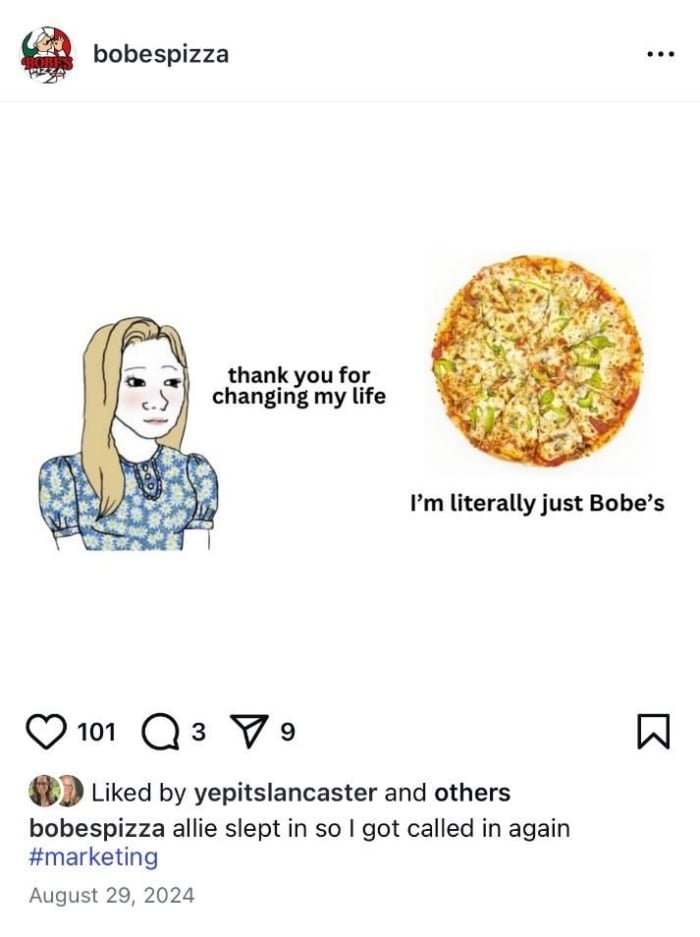

Bobe’s Pizza may be a small Indiana brand, but they lean on authentic content that resonates with their core audience.
The bottom line is that the future of trendjacking isn’t about being fast. It’s about being fast, smart, and real while building systems to let your brand respond with agility and intention.
While both strategies involve jumping into timely conversations, the difference lies in what you’re responding to. Newsjacking is about inserting your brand into breaking news stories — typically through PR or expert commentary — while trendjacking taps into broader online trends, like memes, pop culture moments, or viral challenges. Trendjacking is more social and creative, whereas newsjacking is often more formal and media-facing.
A classic example is Oreo’s “You can still dunk in the dark” tweet during the 2013 Super Bowl blackout. The brand reacted in real time with a witty graphic and caption, and the internet loved it. More recently, brands like Ryanair and Duolingo have gone viral for trendjacking TikTok memes using their unique, offbeat brand voices. The key to successful trendjacking? Speed, creativity, and cultural fluency.
When done well, trendjacking helps brands increase visibility, boost engagement, and connect with audiences in a culturally relevant way. It shows your brand has personality and a pulse. Beyond racking up likes, the real value comes from building brand affinity, sparking conversations, and staying top-of-mind in an increasingly noisy digital space.
Trendjacking is about moving fast and smart. When you do it right, it can drive massive visibility and deepen brand affinity. It takes planning, awareness, and a clear voice to avoid the pitfalls and stand out in the scroll. Whether it’s memes, moments, or movements, show up with purpose.
If you need help crafting an agile social strategy that’s authentic and audience-focused, contact NP Digital to help you lead the conversation, not just follow it.
Google’s Gary Illyes explains the process of indexing content and offers a tip on how to improve crawl budget.
The post Google Explains The Process Of Indexing The Main Content appeared first on Search Engine Journal.
LinkedIn is the best platform for building professional connections, finding B2B leads, and job hunting. But in order to make the most of the platform, you need a LinkedIn headline that’s going to stand out.
Below, we discuss what a LinkedIn headline is, how you can write a good one, plus showcase 20 amazing examples you can use for inspiration.
A LinkedIn headline is a short description of who you are/what you do that sits at the top of your LinkedIn profile. As you can see below, my LinkedIn headline is “Co-Founder at Neil Patel Digital.” Short, sweet, and to the point.
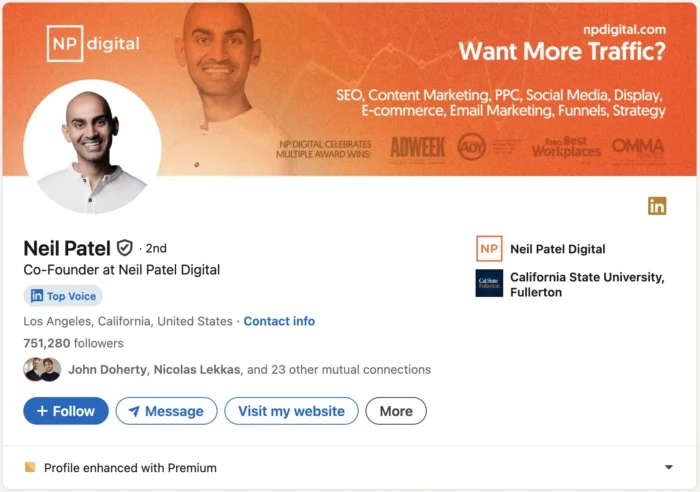

There are a number of ways to write your LinkedIn headline. You can keep it simple like mine, share a bit more about what you do, or infuse some personality into it. Just make sure it matches your overall personal brand—more on that later.
To craft a LinkedIn headline that grabs attention and really showcases who you are, there are a few key elements you want to include. Follow along with these steps to write a good headline that properly details who you are and what you do.
Before you even put a single word in your headline, look around the platform to see how others describe themselves. You can also scroll down just a bit to see 20 amazing LinkedIn headlines we’ve hand-picked to share with you.
Looking around at how other users have written their headlines can be a great way to get the creative juices flowing in your brain. Plus, you can figure out styles that don’t suit you, giving you some parameters to start with.
Now let’s get down to business. It’s time to start writing your LinkedIn headline. And the first thing you want to do is write down your current role.
Keep it simple. Something like “VP of Marketing at Company” or “Dev Lead.” And if you’re currently unemployed and job hunting, you can share that, as well, by writing out something like “Searching for a role in the HR tech space.”
Next, include any relevant skills and expertise you have that will help you stand out. This can be really simple and in list form, like “Content Strategy, Product-Led SEO.” Or you can be a bit wordier and write something like “I build landing pages that convert.”
Including your best skills and experience can help you stand out, especially if you’re job hunting, looking for new clients, or aiming to expand your professional network.
One major component of LinkedIn is its search functionality. And to make sure you appear in search results when people are looking for someone with the type of experience you have is to incorporate the right keywords into your headline.
You don’t want to create a keyword-stuffed, jargon-filled LinkedIn headline. But you do want to incorporate enough keywords that they sound natural while still helping you boost your profile’s ranking in search results.
Don’t be afraid to show off a bit with your headline. You’re good at what you do. Let it be known. For example, you could include something like “Built a channel with 1M+ YouTube subscribers” or “Building a bootstrapped SaaS product.”
Or, you can talk about what you do for clients. Like, “I write high-converting website copy,” or “I create social media ad campaigns that get results.”
LinkedIn is a professional social networking platform. The goal is to increase your online network, whether that’s finding new clients, making new colleagues, or meeting new industry professionals. And one great way to do that is to really sell what you can do.
Just because LinkedIn is a professional platform doesn’t mean you can’t still let your personality come through in your headline and in your content. Include a line that provides a bit more context into who you are as a person—and not just as a professional.
We’ve included a few examples below of how some users have chosen to showcase their personality, even while remaining professional.
You only have 220 characters to sum up exactly what you do and who you are in your LinkedIn headline. It’s like the shortest elevator pitch ever. So you need to find the right words to introduce yourself to other LinkedIn users in a really short, concise way.
Another pro tip: Keep the most important part of your headline at the beginning. In both search results and the LinkedIn feed, people will only see the first several words of your headline. They have to click to your profile to see the entire thing.
Make your headline short and sweet, but also, make them want to click to see more about what you have to offer.
If you want to create your own impactful LinkedIn headline, you first need to look around and see how others in your industry are composing there. Here are 20 different ideas you can steal for your headline to get you started.
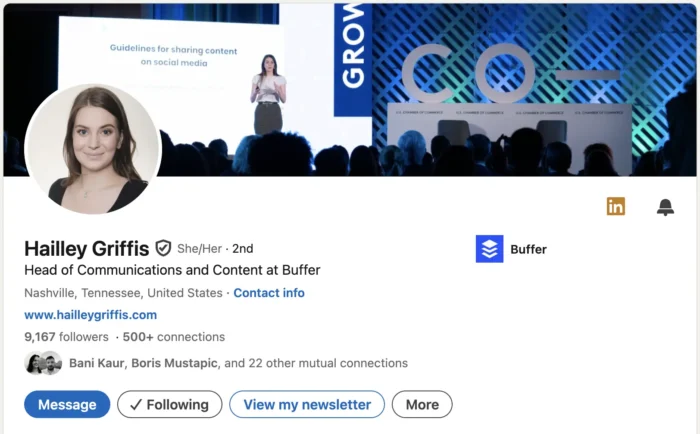

Similar to my headline, you can choose to just be straightforward, sharing nothing but your existing role. Don’t worry about any added fluff—just include what you do and where you work so your new connections know exactly what to expect from you.
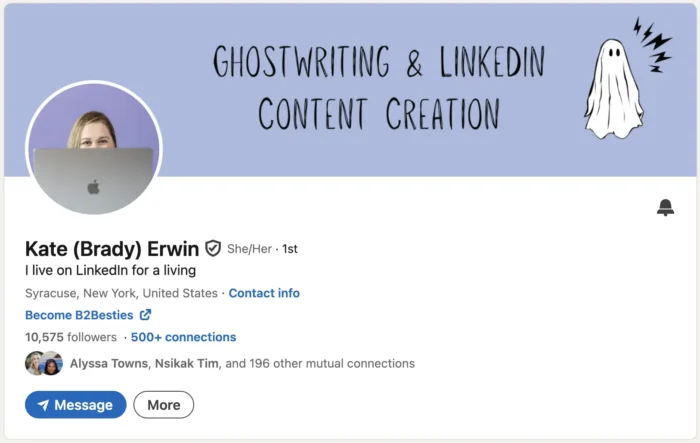

Or, you can choose to have some fun with your LinkedIn headline. Infuse your personality into it, creating a headline that’s still relevant to what you do but also lets you showcase a bit of who you are.
This example, “I live on LinkedIn for a living,” works because Kate is a LinkedIn content creator. So she’s able to put a bit of who she is into her headline while still remaining true to her professional work.
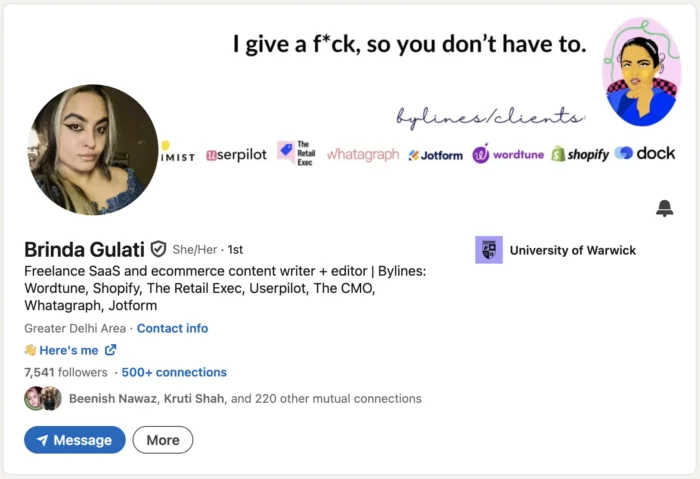

In this example, we see the freelancer has included companies she’s worked with in the past right inside of her LinkedIn headline. This is a great way for potential clients to see if she’ll be a good fit right off the bat.
Consider incorporating some of your past or current clients within your own headline, especially if you only work with companies within a specific industry. It can help narrow down your incoming work requests to more relevant brands.
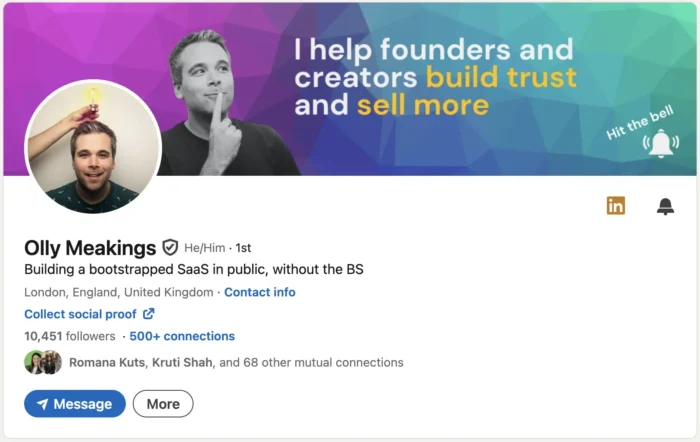

With this example, Olly has let his followers and connections know exactly what to expect from him and his content. He’s building in public, sharing his experience, and providing content that others in the same boat might be interested in.
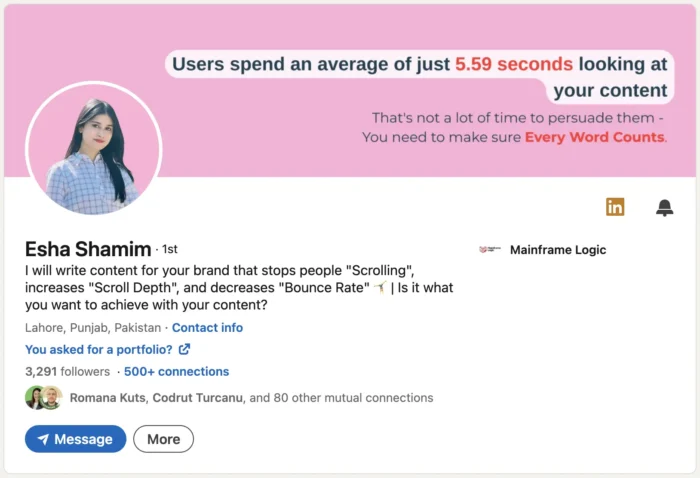

Use your LinkedIn headline as a sort of elevator pitch, promoting yourself and your product or services. In this example, Esha has written that she will write content for your brand that will keep people from scrolling past.
For your own headline, come up with a quick one-liner that perfectly encapsulates what you do so you can use your LinkedIn profile as a way to bring in new work.


Another simple way to use your LinkedIn headline is by simply making a list. List out different roles you have, share a few things about yourself like we see in this example, or list out some of your different skills.
This is a great example because you can use it in any way. Use characters like the “|” or “-” to separate your list items in a visually appealing way that’s easy to follow.
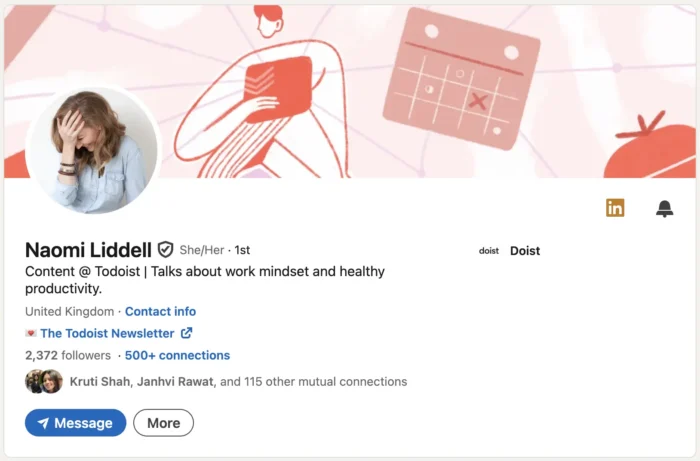

Let new connections know what kind of content to expect from your LinkedIn posts. By sharing the topics you talk about, you can find like-minded connections and colleagues that are going to be much more likely to engage with you on the platform.
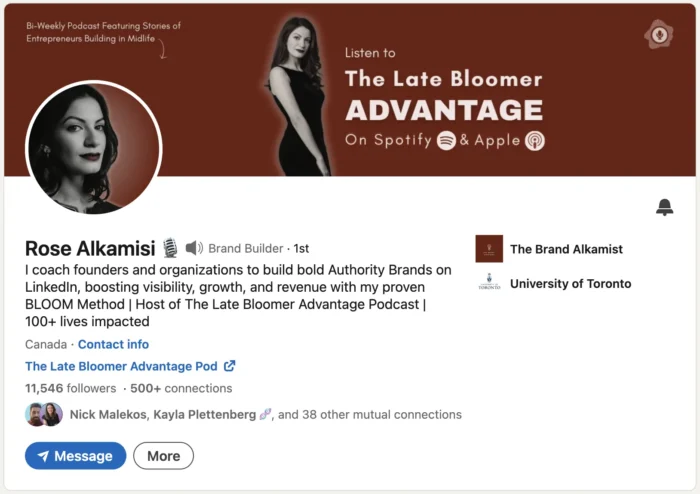

Explain exactly what you do so that LinkedIn users understand if they want to connect with you or not. This is also a great way to find new work, by creating a one-two line overview of what you have to offer potential clients.


If you’ve been working on building up your personal brand, make sure your LinkedIn headline matches that voice or branding. In the above example, we can see this creator incorporates all lowercase letters into their overall voice and branding. So of course it makes sense for her to continue that right within her headline.
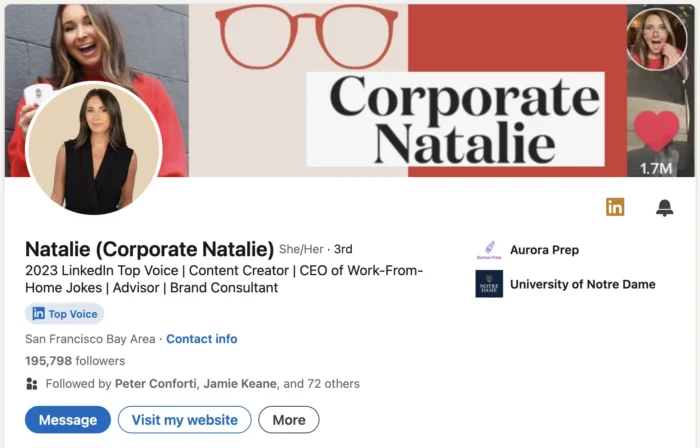

If you’ve won awards or other accolades that are relevant to your work, why not tout them within your LinkedIn headline? Include major accomplishments right inside your headline to further promote your expertise within your profession.
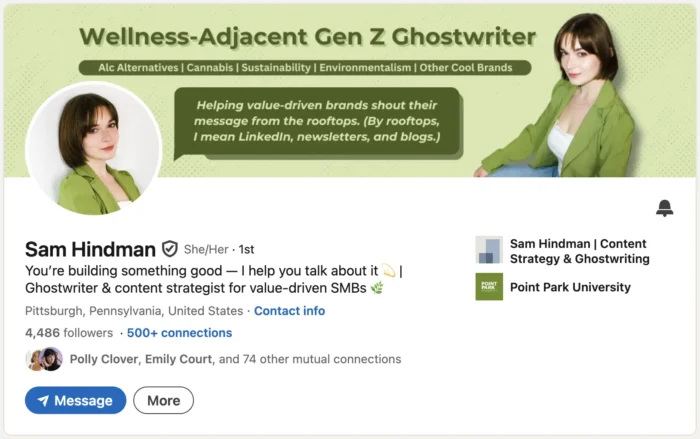

Again, your LinkedIn headline can be treated like a short and sweet elevator pitch. With that in mind, one great way to use it is by creating a tagline of sorts that shows off what you do within a catchy one-liner that can stick in potential clients’ minds.
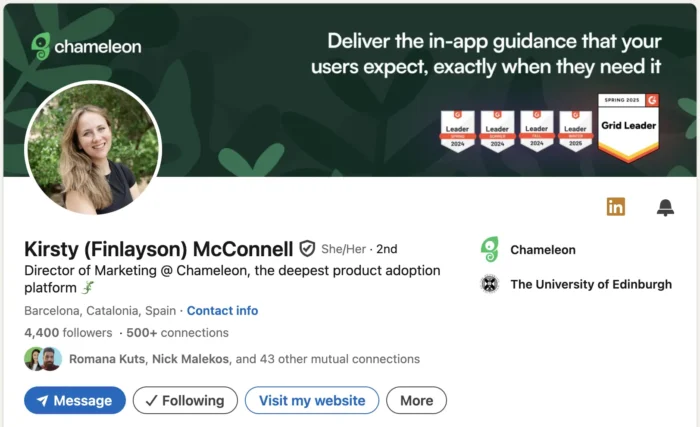

This example is great because not only does it share the user’s exact role, but she also added some additional product promotion. So instead of just seeing that Kirsty works at Chameleon, we now know exactly what type of company it is, and she’s included an adjective that helps sell it even further.
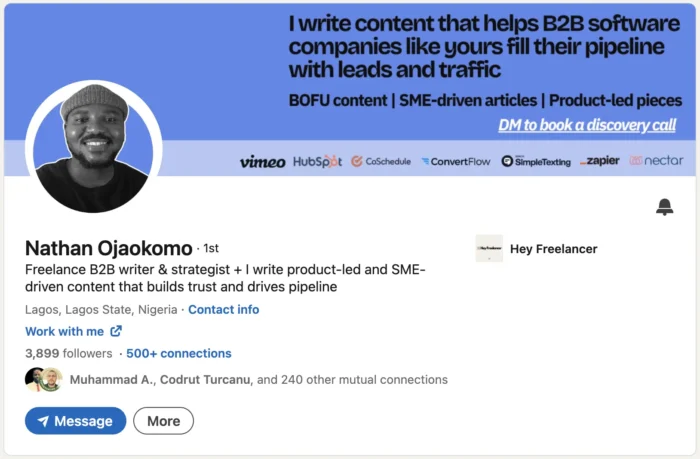

What do you have to offer potential clients, customers, or employers? Write out your value proposition and include it as part of your LinkedIn headline. This is another great way to try to promote your product or services and generate new work through the platform.


Take a page out of Liz Willits’ book and just throw some humor into your headline. Just because LinkedIn is a professional platform doesn’t mean everyone’s headlines need to be formal and stuffy. This review from her mom showcases that Liz enjoys infusing humor into her work.
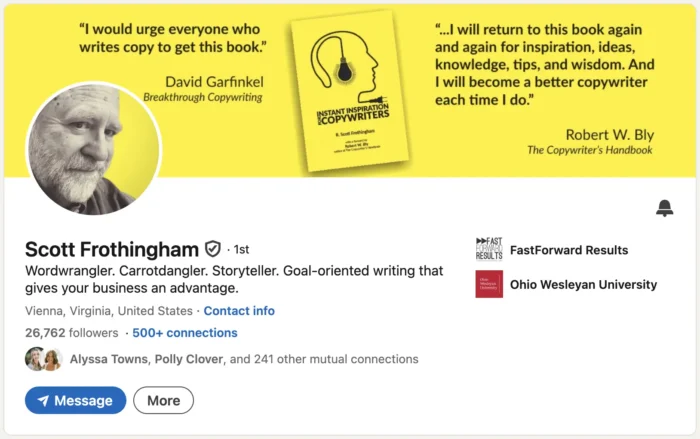

Incorporating buzzwords can be a great way to grab attention. It’s the perfect example in this instance as Scott is a copywriter, so throwing in these big, eye-catching buzzwords not only intrigues potential connections but also showcases a bit of what he can do.
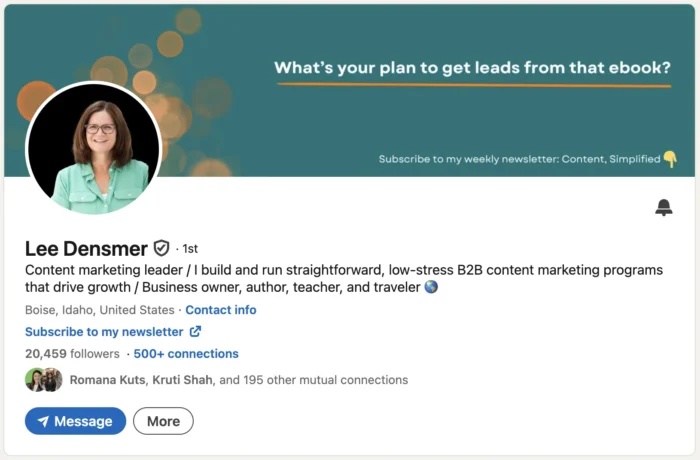

If you have multiple roles you want to promote, include all of them within your headline. We see Lee doing this in the last line of her headline, listing out, “Business owner, author, teacher, and traveler.”
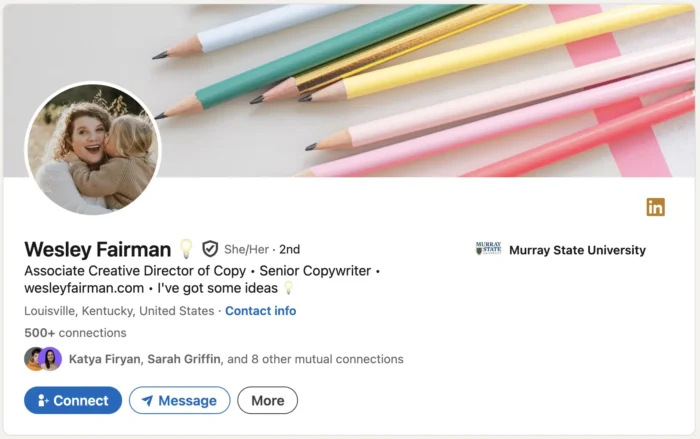

You can include a link within your LinkedIn profile, but why not make it even easier for people to discover where they can learn more about you or your business by sharing a link right inside of your LinkedIn headline? It won’t be clickable, but viewers can easily copy and paste it into their browser bar.
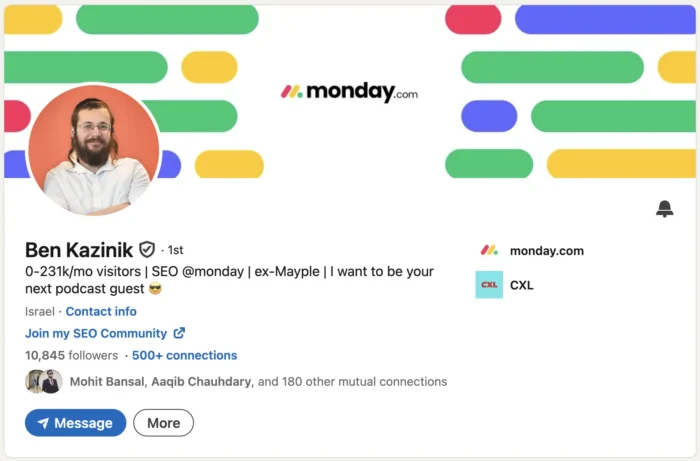

Proud of your professional achievements? Show them off. We see Ben doing just this by sharing that he boosted monday.com’s monthly visitors from nothing up to 231k. Including tangible accomplishments like this can be a great way to showcase what you can do for potential clients and employers.
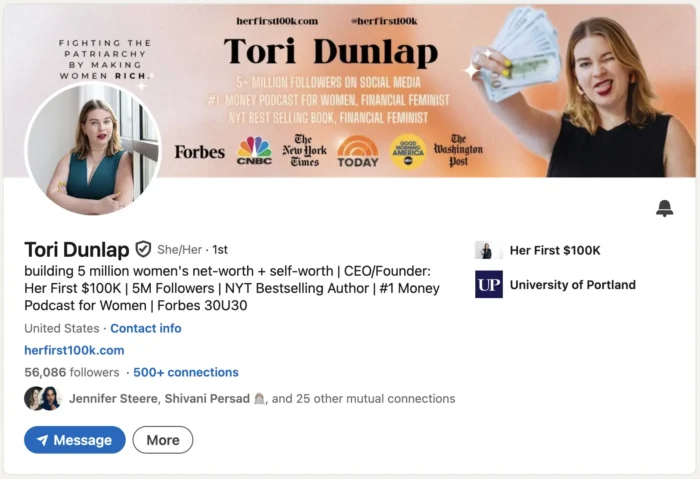

Showcase your professional mission right inside your LinkedIn headline. In this example, we see Tori sharing that she wants to build five million women’s net-worth and self worth. Sharing this is important as it’s a main part of her overall business goals. It also helps her to stand out to her potential audience.
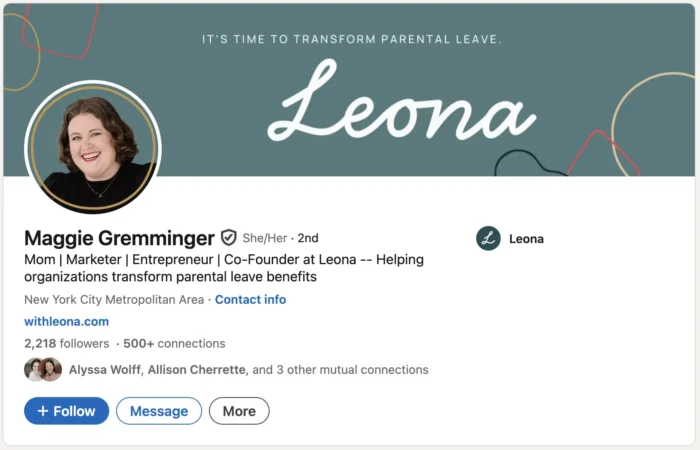

You don’t need to keep your professional and personal self separated. Feel free to include personal details in your LinkedIn headline—especially if they’re relevant to your professional role. In this instance, we see Maggie share that she’s a mom right inside her headline. This makes sense for her as she’s building a platform focused on transforming parental leave.
It’s the short line of text right under your name on your LinkedIn profile. Think of it like a quick intro. it tells people what you do and why they should care. It shows up in search results, connection requests, and posts, so it’s one of the first things people see.
Start with your role or title. Then add what you’re good at or what makes you different, including things like skills, results, industry keywords, or a short value proposition. Keep it tight, use natural language, and make sure it actually sounds like you. Bonus points if it sparks curiosity or shows some personality.
Write your own LinkedIn headline by taking advantage of the tips and examples we’ve included throughout this article. Your headline should showcase what you do professionally, the kinds of content you share, and what your skills are so your new connections know what to expect.To make the most out of your Linkedin presence, check out my guide on LinkedIn marketing next.
Your site lost 30% of organic traffic after a migration. Kevin Gibbons answers why and shares how to get rankings back.
The post Ask An SEO: How Can We Recover A 30% Drop In Organic Traffic From A Site Migration? appeared first on Search Engine Journal.
Microsoft analyzed 200,000 AI workplace conversations to learn how AI is reshaping marketing and sales roles. Here’s what the data shows.
The post Which Marketing Jobs Are Most Affected by AI? appeared first on Search Engine Journal.
SMS marketing is an effective way to meet your target audience exactly where they are—their smartphones. With short snippets of text messages, SMS marketing can be a great way to engage customers and boost sales.
Throughout this article, we’re going to dive deeper into what a successful SMS marketing strategy looks like, plus some top tips and tools for making it work for your business.
SMS marketing is a promotional strategy that uses text messaging to communicate with current and potential customers. Due to the nature of texting, SMS marketing tends to focus more on short promotional messages like discounts, sales, product launches, and low stock alerts.
SMS marketing is a newer strategy so it comes with a lot of benefits that not many companies are taking advantage of yet. If you’re considering creating an SMS marketing strategy, these perks might be just the thing to sway you.
Of all the types of digital marketing—social media, content, email, etc.—SMS marketing is one of the lesser used tactics. This can give you an edge because customers aren’t inundated with marketing texts the way they are with marketing emails or social media posts.
So if someone in your target audience opts in for SMS communication, you can be sure that they’re probably actually reading your text, and not just sending it to the trash because their inbox is overflowing with messages from brands.
People tend to open text messages they receive faster than new emails. In fact, 90% of people open new texts within the first three minutes. This means you can watch your results come in much more quickly with SMS messages than with emails, getting a sense of how your texts are performing almost instantly.
Not only do you see faster results, but you see better results. Text messages have a 98% open rate, 5x the open rate of marketing emails. Most businesses see an SMS click-through rate between 21-35%, meaning people are also interacting with their texts.
Plus, the opt-out rate is just 1-2%, meaning people tend to stick around with text message marketing more than via other channels.
SMS marketing can be a huge part of a successful omnichannel marketing strategy. Let people hear from your business in their preferred channels, and make it easy for them to shop via mobile by sending promotional messages straight to their smartphones.
Texting is a much more personal form of communication. But more than that, you can make it even more personal by using their name, segmenting people based on their behavior with your business, and bringing a really personalized approach to your strategy.
SMS marketing is a cost-effective way to promote your business and its products or services. You just need an SMS marketing platform and some copy—no need for additional visuals or assets, making this a quick and easy strategy to get up and running.
To make the most out of your SMS marketing strategy, you need to implement some best practices. These tips can boost your results and help your SMS communications perform even better.
Just like with email marketing, you must receive an actual opt-in or consent from a customer to start sending them text message communication. Your business must comply with the Telephone Consumer Protection Act (TCPA) if you or your customers are in the United States, or whatever SMS regulations are available in your audience’s country/ies.
This doesn’t have to be a complicated process. Ask for people to opt into your text message communications the same way you would ask them to sign up to receive your email newsletter.
Take a look at this example from Crate and Barrel’s website to see what we mean:
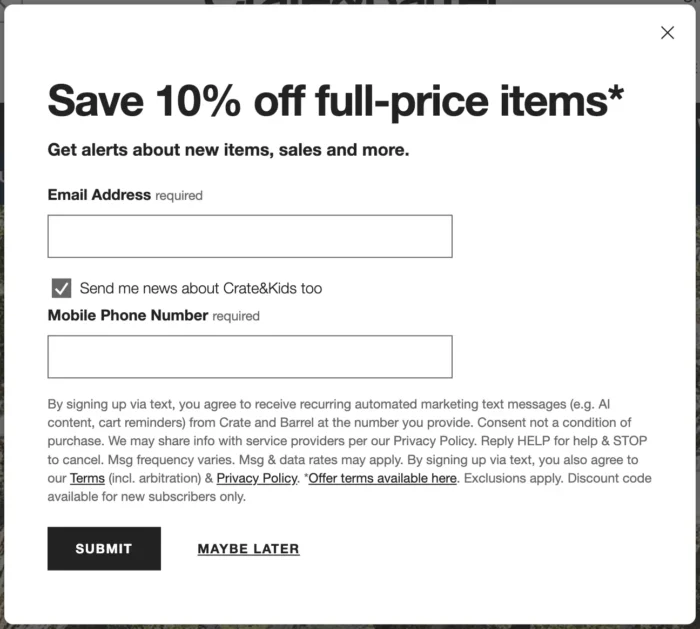

Want to boost your SMS subscribers? Give them an offer they can’t refuse. Many businesses use pop-ups on their website to ask people to opt-in to their email and/or text communications by offering a discount code.
Here’s an example from soda brand Poppi:
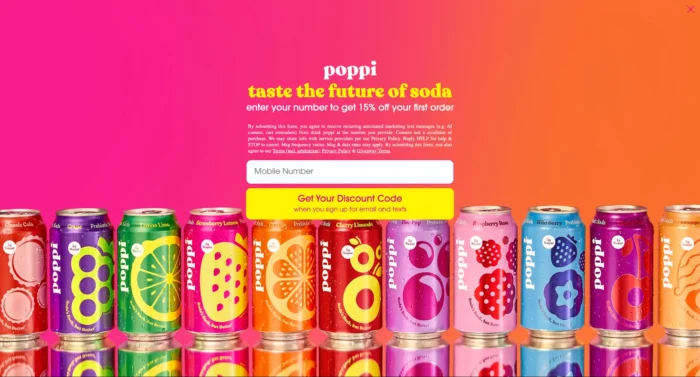

A 15% off discount isn’t a bad deal for simply handing over your email address and phone number. And it’s just on the customer’s first order. So you’re likely generating a new customer at the same time you’re getting them to opt into marketing communications. Win-win, right?
The maximum character count for SMS messages is 160 characters, so your texts need to be short and sweet, conveying your message in just a quick sentence or two. But more than that, people don’t want to open a text message to a wall of content—unless they’re getting the latest gossip from their friends.
Take a page out of beauty brand NaturAll’s book. Each of their marketing texts is straight to the point, letting customers know exactly what they’re promoting, whether it’s a $9.99 sale or a new product:
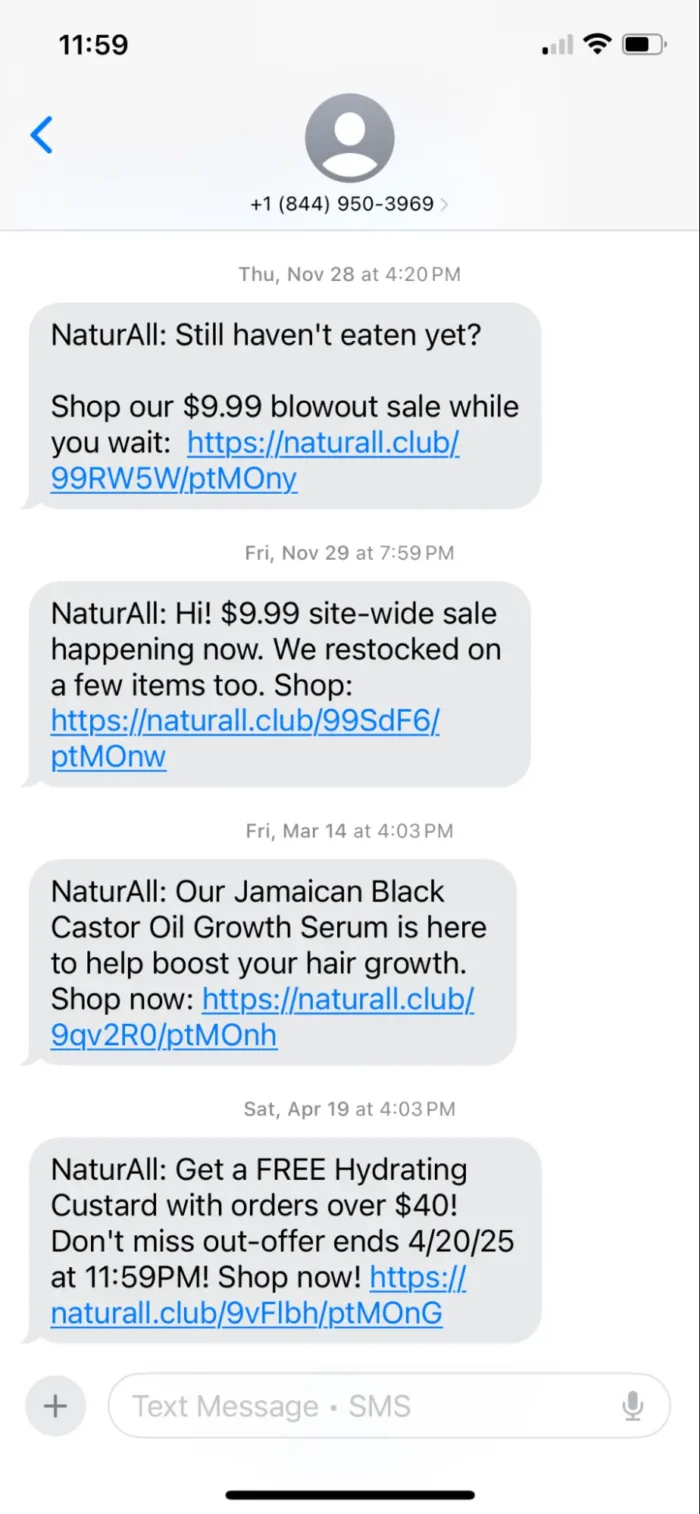


Not everyone who opts into your SMS messages is going to save your company’s contact information. This means it’s important to identify yourself in each message you send.
Here’s an example from mattress company Casper. The brand includes its company name at the start of every text it sends—a common way for brands to identify themselves right from the jump:
Text message timing is a bit more sensitive than email timing. Most people don’t receive email notifications straight to their phone, whereas texts alert them every time. This means you need to ensure you’re sending your text communication during times you won’t be interrupting your customers.
Many regulations even have parameters in place to ensure companies can’t bother consumers during inopportune times. For example, according to the TCPA, companies cannot send text messages between the hours of 9PM and 8AM in their local time zones.
So you need to keep timing in mind so you’re not sending messages during the wrong time frame. But you also want to optimize your timing to improve the chances that your customers will take action after reading your messages.
If you look back at our example from Casper, you can see that the brand sends its text messages at 12:01PM like clockwork. Try to find a time between 10AM and 5-6PM that seems to work for your brand.
If you send too many text messages, you’re going to have an extremely high opt-out rate. Analysis from SMS marketing platform Attentive shows that sending more than 10-15 messages per month can make your opt-out rate skyrocket.
This is different from email marketing, where some industries send daily emails. Instead, you want to max out at 1-2 text messages per week, sometimes going as infrequent as 2-4 texts per month.
Many brands use their SMS strategies just to send out discount/sale alerts, product launches, low stock reminders, and more. However, you should expand your strategy and send out more than just promotional messages.
You can use your SMS marketing communications for:
Look at this example from baby formula brand Enfamil. The company sends out plenty of promotional messages, while balancing out their communication with educational content, too:
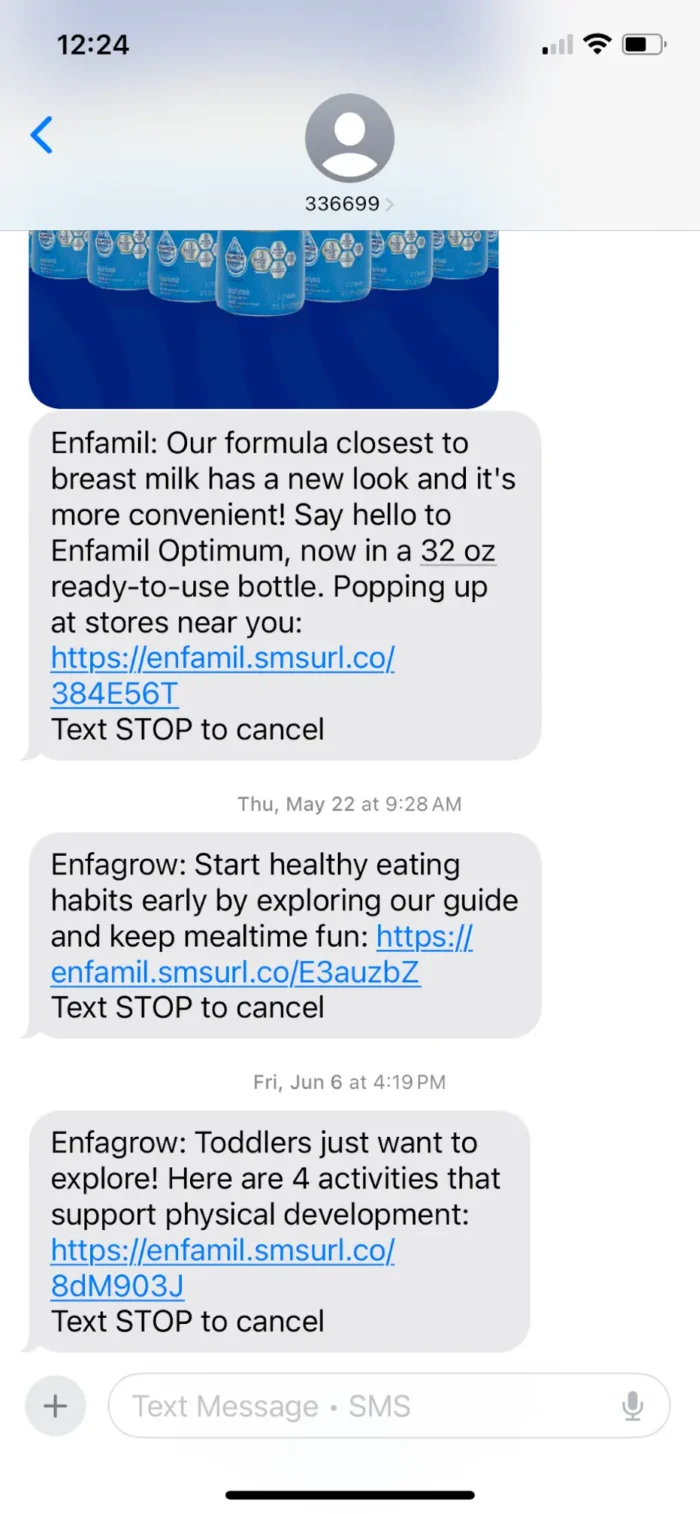


What action do you want your text recipients to take? Make it clear by ending your messages with a call to action (CTA). This can be a simple “Shop now,” or “Learn more.”
Take a look at how organic baby brand Snuggle Me adds a call to action at the end of each of its messages, making it easy for the recipient to take the exact desired action:
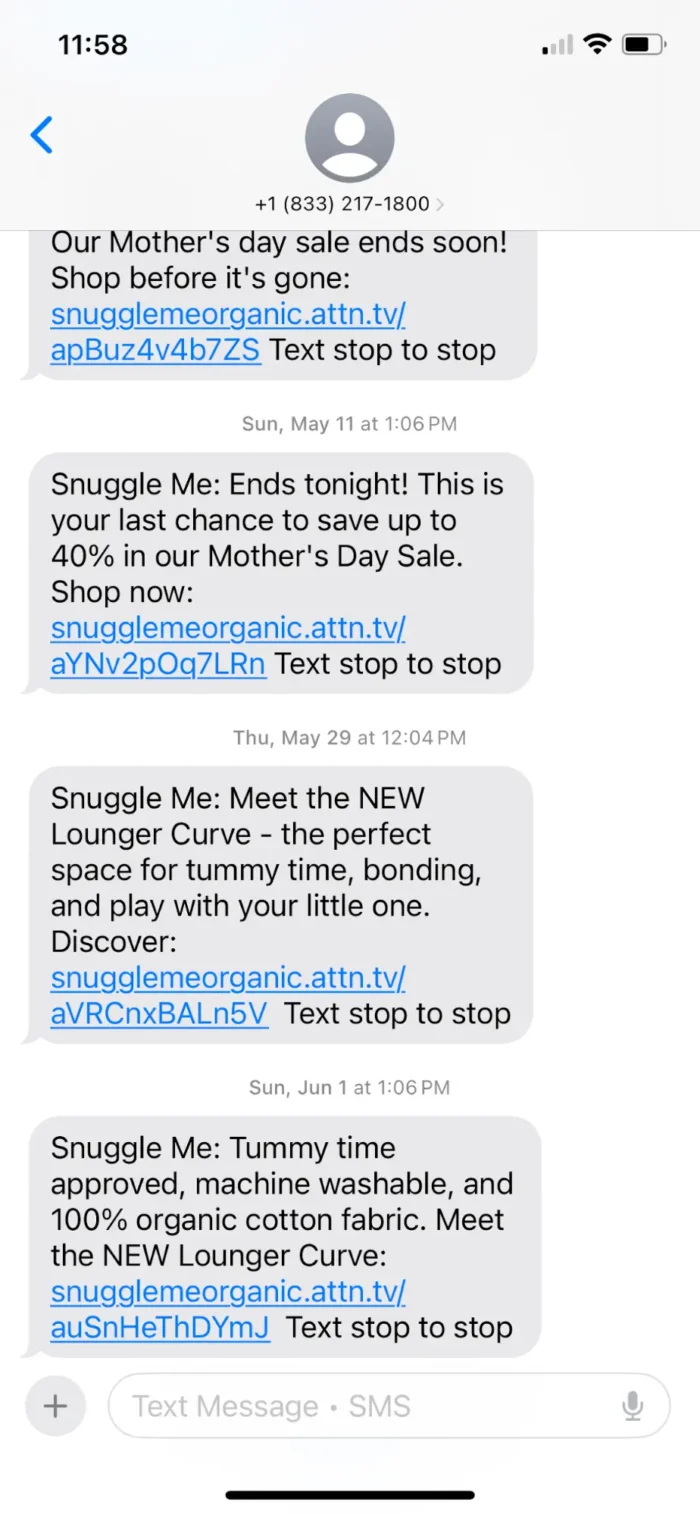


If you’re using SMS marketing to send people to your website, they’re almost always going to be clicking to your site using their mobile device. If your website isn’t mobile -friendly, you’re essentially losing customers as soon as they click, making your SMS efforts completely obsolete.
If you’re going to use SMS marketing, your website needs to be mobile friendly so customers can click your links, shop around, and check out all via their mobile devices.
Just like with email, you don’t want your customers to have to jump through hoops to unsubscribe. They’ll get frustrated if they can’t easily figure out how to opt out from receiving texts from your brand.
Take a look back at our example from Snuggle Me. Every single text ends with “Text stop to stop.” Enfamil ends theirs with “Text STOP to cancel.”
Use a similar strategy to make sure your recipients know exactly what to do if they decide they’re not interested in hearing from your business anymore.
If you want to launch your own SMS marketing strategy, you need the right tool to help. These SMS marketing tools are perfect for creating, sending, and analyzing your text campaigns.
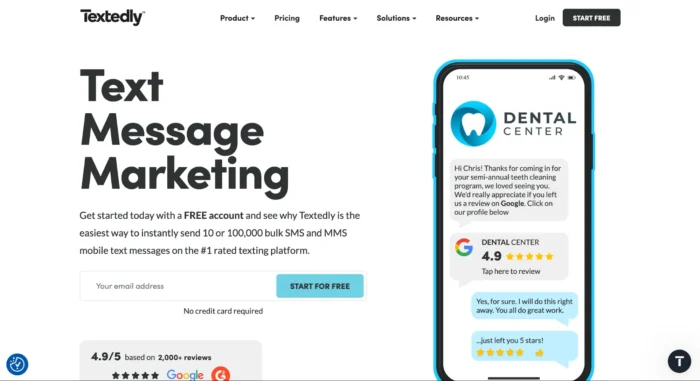


Textedly is a great SMS marketing platform for businesses looking to send out mass marketing messages, as well as have 1:1 conversations with their customers. Send out your marketing texts while also reaching customers directly to send appointment reminders, ask for reviews, and more.
Pricing: Free for your first 50 text messages. Paid plans start at $26/month for up to 600 monthly messages.
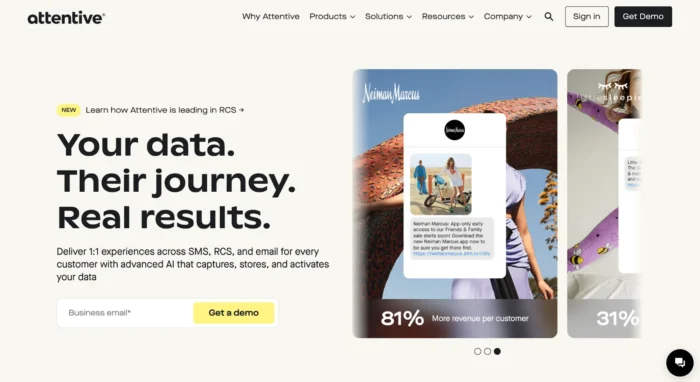


Attentive is a great tool for businesses looking to combine their SMS and email strategies as you can send both types of communication using this platform. It also offers RCS messaging, which is a more modern version of messaging that incorporates additional features from platforms like iMessage and WhatsApp.
Pricing: Request a demo to get pricing information.
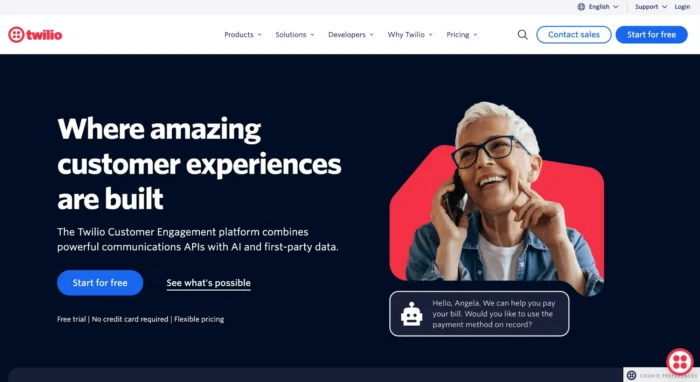


Twilio is a customer engagement software that makes it possible for businesses to connect with their audience via platforms like SMS messaging, email communication, voice chat, and video. This is a great way for your brand to build an omnichannel experience seamlessly through just a single tool.
Pricing: Pricing varies based on the types of communication you want to send out.
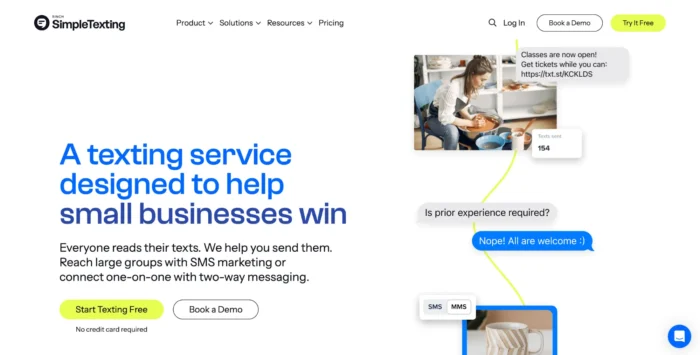


SimpleTexting is an SMS marketing service that lets you send out mass marketing messages or communicate one-on-one with your customers. If you want to offer text message customer service so your audience can reach you directly via their mobile phones, this is the perfect platform to get started with.
Pricing: Plans start at $39/month for 500 messages/month.
Textmagic is another platform that makes it easy to send both SMS and email communication from one seamless dashboard. Create interconnected campaigns to promote your business and analyze your results in the Textmagic interface.
Pricing: Plans vary based on your usage. For example, for just 500 texts and 500 emails/month, you’ll pay just $37.50/month. It’ll go up from there, based on how many messages you’re sending so you’re never paying for messages you don’t need.
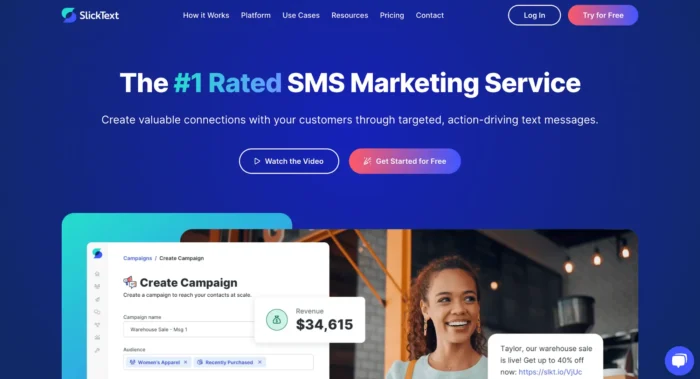


SlickText makes it easy to send comprehensive SMS marketing campaigns, letting you put together one-off messages, create automated workflows based on how customers respond to your promotions, and segment out your audience to personalize your messaging.
Pricing: Plans start at $29/month for up to 500 monthly messages.
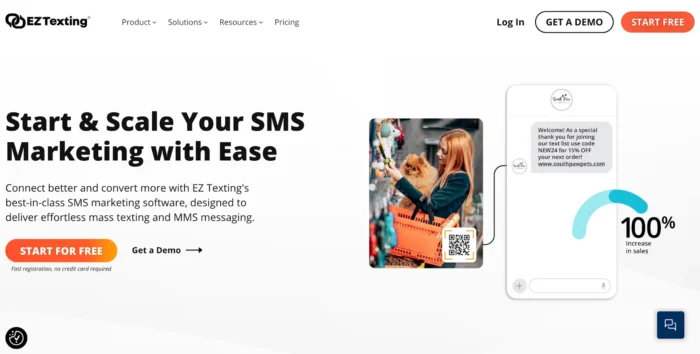


EZ Texting is another great SMS marketing platform that enables brands to send mass marketing messages, hold one-on-one conversations, create text automations, and more. With EZ Texting, you can even get access to AI tools that help you compose texts so your brainstorming and content creation process is jumpstarted for you.
Pricing: Plans start at $20/month for up to 500 contacts.
SMS, or short messaging services, refers to using text messages to communicate with leads or customers. Brands can share promotions, news, shipping updates, and more.
If you don’t use them correctly, SMS marketing can definitely backfire and annoy your customers. Make sure to ask permission, make it easy for consumers to opt-out, and only send specific or time-sensitive messages — such as a sale.
No, it’s often much cheaper than other types of marketing like paid ads because each message usually only costs a few cents each to send.
SMS marketing is cost-effective, easy to deploy, and incredibly effective because messages are delivered directly to users’ phones.
Yes, when it’s done right. People open texts faster than emails, and they’re way more likely to read them. SMS has higher engagement, lower competition, and quicker results. If your list is opted-in and your timing’s smart, SMS can drive real revenue.
SMS marketing is a key strategy for communicating with your customers in a quick and easy way. Share sales, discounts, launches, educational content, and more in a digestible format that your audience will receive almost instantly. If you want to implement even more great ways to reach your audience, I’ve also created a full guide to email marketing you won’t want to miss.
Google Search expands AI Mode with PDF uploads, planning tools, video input, and Chrome integration, offering new ways to interact with search.
The post Google AI Mode Update: File Uploads, Live Video Search, More appeared first on Search Engine Journal.
SMS marketing is an effective way to meet your target audience exactly where they are—their smartphones. With short snippets of text messages, SMS marketing can be a great way to engage customers and boost sales.
Throughout this article, we’re going to dive deeper into what a successful SMS marketing strategy looks like, plus some top tips and tools for making it work for your business.
SMS marketing is a promotional strategy that uses text messaging to communicate with current and potential customers. Due to the nature of texting, SMS marketing tends to focus more on short promotional messages like discounts, sales, product launches, and low stock alerts.
SMS marketing is a newer strategy so it comes with a lot of benefits that not many companies are taking advantage of yet. If you’re considering creating an SMS marketing strategy, these perks might be just the thing to sway you.
Of all the types of digital marketing—social media, content, email, etc.—SMS marketing is one of the lesser used tactics. This can give you an edge because customers aren’t inundated with marketing texts the way they are with marketing emails or social media posts.
So if someone in your target audience opts in for SMS communication, you can be sure that they’re probably actually reading your text, and not just sending it to the trash because their inbox is overflowing with messages from brands.
People tend to open text messages they receive faster than new emails. In fact, 90% of people open new texts within the first three minutes. This means you can watch your results come in much more quickly with SMS messages than with emails, getting a sense of how your texts are performing almost instantly.
Not only do you see faster results, but you see better results. Text messages have a 98% open rate, 5x the open rate of marketing emails. Most businesses see an SMS click-through rate between 21-35%, meaning people are also interacting with their texts.
Plus, the opt-out rate is just 1-2%, meaning people tend to stick around with text message marketing more than via other channels.
SMS marketing can be a huge part of a successful omnichannel marketing strategy. Let people hear from your business in their preferred channels, and make it easy for them to shop via mobile by sending promotional messages straight to their smartphones.
Texting is a much more personal form of communication. But more than that, you can make it even more personal by using their name, segmenting people based on their behavior with your business, and bringing a really personalized approach to your strategy.
SMS marketing is a cost-effective way to promote your business and its products or services. You just need an SMS marketing platform and some copy—no need for additional visuals or assets, making this a quick and easy strategy to get up and running.
To make the most out of your SMS marketing strategy, you need to implement some best practices. These tips can boost your results and help your SMS communications perform even better.
Just like with email marketing, you must receive an actual opt-in or consent from a customer to start sending them text message communication. Your business must comply with the Telephone Consumer Protection Act (TCPA) if you or your customers are in the United States, or whatever SMS regulations are available in your audience’s country/ies.
This doesn’t have to be a complicated process. Ask for people to opt into your text message communications the same way you would ask them to sign up to receive your email newsletter.
Take a look at this example from Crate and Barrel’s website to see what we mean:


Want to boost your SMS subscribers? Give them an offer they can’t refuse. Many businesses use pop-ups on their website to ask people to opt-in to their email and/or text communications by offering a discount code.
Here’s an example from soda brand Poppi:


A 15% off discount isn’t a bad deal for simply handing over your email address and phone number. And it’s just on the customer’s first order. So you’re likely generating a new customer at the same time you’re getting them to opt into marketing communications. Win-win, right?
The maximum character count for SMS messages is 160 characters, so your texts need to be short and sweet, conveying your message in just a quick sentence or two. But more than that, people don’t want to open a text message to a wall of content—unless they’re getting the latest gossip from their friends.
Take a page out of beauty brand NaturAll’s book. Each of their marketing texts is straight to the point, letting customers know exactly what they’re promoting, whether it’s a $9.99 sale or a new product:



Not everyone who opts into your SMS messages is going to save your company’s contact information. This means it’s important to identify yourself in each message you send.
Here’s an example from mattress company Casper. The brand includes its company name at the start of every text it sends—a common way for brands to identify themselves right from the jump:
Text message timing is a bit more sensitive than email timing. Most people don’t receive email notifications straight to their phone, whereas texts alert them every time. This means you need to ensure you’re sending your text communication during times you won’t be interrupting your customers.
Many regulations even have parameters in place to ensure companies can’t bother consumers during inopportune times. For example, according to the TCPA, companies cannot send text messages between the hours of 9PM and 8AM in their local time zones.
So you need to keep timing in mind so you’re not sending messages during the wrong time frame. But you also want to optimize your timing to improve the chances that your customers will take action after reading your messages.
If you look back at our example from Casper, you can see that the brand sends its text messages at 12:01PM like clockwork. Try to find a time between 10AM and 5-6PM that seems to work for your brand.
If you send too many text messages, you’re going to have an extremely high opt-out rate. Analysis from SMS marketing platform Attentive shows that sending more than 10-15 messages per month can make your opt-out rate skyrocket.
This is different from email marketing, where some industries send daily emails. Instead, you want to max out at 1-2 text messages per week, sometimes going as infrequent as 2-4 texts per month.
Many brands use their SMS strategies just to send out discount/sale alerts, product launches, low stock reminders, and more. However, you should expand your strategy and send out more than just promotional messages.
You can use your SMS marketing communications for:
Look at this example from baby formula brand Enfamil. The company sends out plenty of promotional messages, while balancing out their communication with educational content, too:



What action do you want your text recipients to take? Make it clear by ending your messages with a call to action (CTA). This can be a simple “Shop now,” or “Learn more.”
Take a look at how organic baby brand Snuggle Me adds a call to action at the end of each of its messages, making it easy for the recipient to take the exact desired action:



If you’re using SMS marketing to send people to your website, they’re almost always going to be clicking to your site using their mobile device. If your website isn’t mobile -friendly, you’re essentially losing customers as soon as they click, making your SMS efforts completely obsolete.
If you’re going to use SMS marketing, your website needs to be mobile friendly so customers can click your links, shop around, and check out all via their mobile devices.
Just like with email, you don’t want your customers to have to jump through hoops to unsubscribe. They’ll get frustrated if they can’t easily figure out how to opt out from receiving texts from your brand.
Take a look back at our example from Snuggle Me. Every single text ends with “Text stop to stop.” Enfamil ends theirs with “Text STOP to cancel.”
Use a similar strategy to make sure your recipients know exactly what to do if they decide they’re not interested in hearing from your business anymore.
If you want to launch your own SMS marketing strategy, you need the right tool to help. These SMS marketing tools are perfect for creating, sending, and analyzing your text campaigns.



Textedly is a great SMS marketing platform for businesses looking to send out mass marketing messages, as well as have 1:1 conversations with their customers. Send out your marketing texts while also reaching customers directly to send appointment reminders, ask for reviews, and more.
Pricing: Free for your first 50 text messages. Paid plans start at $26/month for up to 600 monthly messages.



Attentive is a great tool for businesses looking to combine their SMS and email strategies as you can send both types of communication using this platform. It also offers RCS messaging, which is a more modern version of messaging that incorporates additional features from platforms like iMessage and WhatsApp.
Pricing: Request a demo to get pricing information.



Twilio is a customer engagement software that makes it possible for businesses to connect with their audience via platforms like SMS messaging, email communication, voice chat, and video. This is a great way for your brand to build an omnichannel experience seamlessly through just a single tool.
Pricing: Pricing varies based on the types of communication you want to send out.



SimpleTexting is an SMS marketing service that lets you send out mass marketing messages or communicate one-on-one with your customers. If you want to offer text message customer service so your audience can reach you directly via their mobile phones, this is the perfect platform to get started with.
Pricing: Plans start at $39/month for 500 messages/month.
Textmagic is another platform that makes it easy to send both SMS and email communication from one seamless dashboard. Create interconnected campaigns to promote your business and analyze your results in the Textmagic interface.
Pricing: Plans vary based on your usage. For example, for just 500 texts and 500 emails/month, you’ll pay just $37.50/month. It’ll go up from there, based on how many messages you’re sending so you’re never paying for messages you don’t need.



SlickText makes it easy to send comprehensive SMS marketing campaigns, letting you put together one-off messages, create automated workflows based on how customers respond to your promotions, and segment out your audience to personalize your messaging.
Pricing: Plans start at $29/month for up to 500 monthly messages.



EZ Texting is another great SMS marketing platform that enables brands to send mass marketing messages, hold one-on-one conversations, create text automations, and more. With EZ Texting, you can even get access to AI tools that help you compose texts so your brainstorming and content creation process is jumpstarted for you.
Pricing: Plans start at $20/month for up to 500 contacts.
SMS, or short messaging services, refers to using text messages to communicate with leads or customers. Brands can share promotions, news, shipping updates, and more.
If you don’t use them correctly, SMS marketing can definitely backfire and annoy your customers. Make sure to ask permission, make it easy for consumers to opt-out, and only send specific or time-sensitive messages — such as a sale.
No, it’s often much cheaper than other types of marketing like paid ads because each message usually only costs a few cents each to send.
SMS marketing is cost-effective, easy to deploy, and incredibly effective because messages are delivered directly to users’ phones.
Yes, when it’s done right. People open texts faster than emails, and they’re way more likely to read them. SMS has higher engagement, lower competition, and quicker results. If your list is opted-in and your timing’s smart, SMS can drive real revenue.
SMS marketing is a key strategy for communicating with your customers in a quick and easy way. Share sales, discounts, launches, educational content, and more in a digestible format that your audience will receive almost instantly. If you want to implement even more great ways to reach your audience, I’ve also created a full guide to email marketing you won’t want to miss.
The best SEO certifications come from Semrush, Udemy, Hubspot, Blue Array, CXL, DMI, and Coursera.